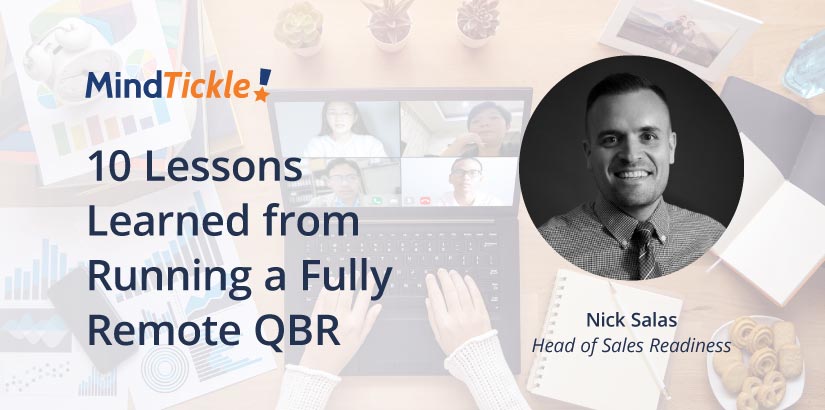Like many other companies at the moment, Mindtickle has been learning to adapt to a 100% virtual environment. As such, we just wrapped up our Q2 Quarterly Business Review (QBR), and we were able to conduct the entire process and meeting virtually. In a way, it was a living QBR with sales and other team members presenting content based on their own lessons learned. Fortunately, it was a success with engagement being strong throughout! But of course, there are always lessons to be learned for making these better and better over time. As the Head of Sales Readiness, I oversaw the QBR ranging from the format and structure to the sessions and post-event engagement. As part of that experience, I wanted to take the opportunity to share some of the lessons learned.
- Make sure you have a theme. Even though I know what the theme was and the objectives, I should have communicated better to the field instead of assuming they would discern the theme by piecing all of the sessions together. Make sure to market the QBR with a lot of excitement ahead of time.
- Pick a platform to support your plan. Without Mindtickle, it would have been difficult to put a logical framework together for the sales teams to follow. Being able to use a platform designed specifically for making virtual QBR’s successful obviously gave me an advantage. But it is important to remember that, regardless of what platform you use to execute the virtual QBR, ensure that the flow and logic of the structure make sense. I constantly checked and re-checked that the sessions were being organized in the proper order and that the times were aligned with the agenda, and the technology helped keep me accountable to that.
- Segment your virtual QBR. Breaks are not only encouraged, they are mandatory if you want your QBR to succeed. You can’t expect to have an engaged team for a full day or a couple of half days without building in some breathing room. I built in three breaks throughout the day and that seemed sufficient, but when creating the agenda, assume that your learners are going to need mental and physical breaks throughout.
- Pre-work is essential. While pre-work is an important part of the virtual QBR, I would incorporate additional activities including having the presenters pre-record some brief messages and shorten the live presenting time. One key learning is resist the urge to schedule 60-minute sessions in a virtual QBR. 30-minute sessions are ideal and even those can test the attention spans of reps. Make the pre-work such that the live presentations take care of themselves and all that are left are questions and possible brief reiteration.
- Keep people excited and engaged. Not only did I build in knowledge checks throughout the day and during breaks, but we also played online games with questions and topics completely unrelated to the QBR content. It shouldn’t be all work and no play and you should give the team an opportunity for a mental break to have some fun.
- Assign a moderator to check messages. As the organizer especially in a virtual environment using Zoom, you’ll likely be bombarded with questions, technical issues, clarification, follow-up, etc. during the QBR, which is not only difficult but stressful. Ask someone to help moderate the questions and the chatter that comes through during the day.
- Do dry runs beforehand. The dry runs we did with the presenters allowed myself, along with sales leadership, to ensure that the message was concise and focused, which helps keep people engaged throughout the day.
- Create breakouts to accommodate different discussions. Something we didn’t do but will certainly incorporate next time, is to use the breakout room feature in Zoom. Give the teams time to digest and talk about how they can apply what they are learning throughout the day in a safe space without worrying about interrupting the sessions.
- Keep participants on their toes and engaged. We’ve all done it – turned off our video during a video call. To keep everyone honest, randomly ask participants to turn on their cameras and say something about themselves throughout the day. This ensures they are staying engaged and provides everyone an opportunity to learn something new about their peers.
- Reinforce knowledge and key learnings through structured post-work. Organize post-QBR work that will make an impact and that will reiterate key themes learned throughout the day. Using Mindtickle, we accomplish this through a series of quizzes and exercises that occur right after the QBR and over several weeks to ensure knowledge reinforcement.
While the feedback was that this was a very successful event, I (and I’m sure my enablement professionals agree) am always looking for ways to improve the experience Every training is as much a learning experience for sales enablement as it is for the sales teams.
I hope these insights are useful and I invite fellow sales readiness and enablement professionals to comment and join the discussion. For more blogs like this and other resources to help keep teams remote and ready, visit our “Remote and Ready” page.



 By Rahul Mathew
By Rahul Mathew

